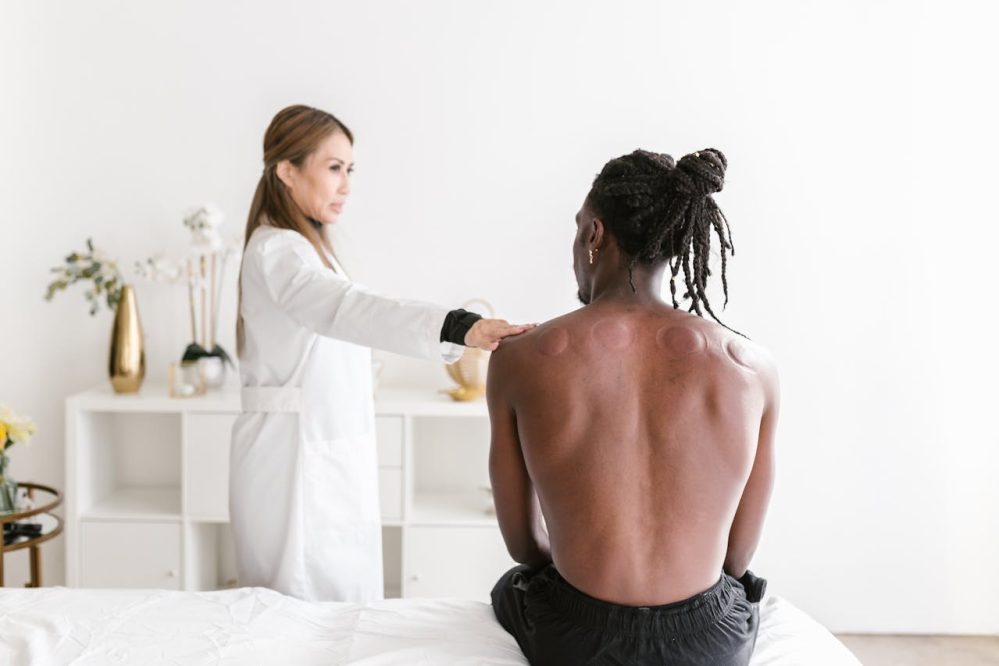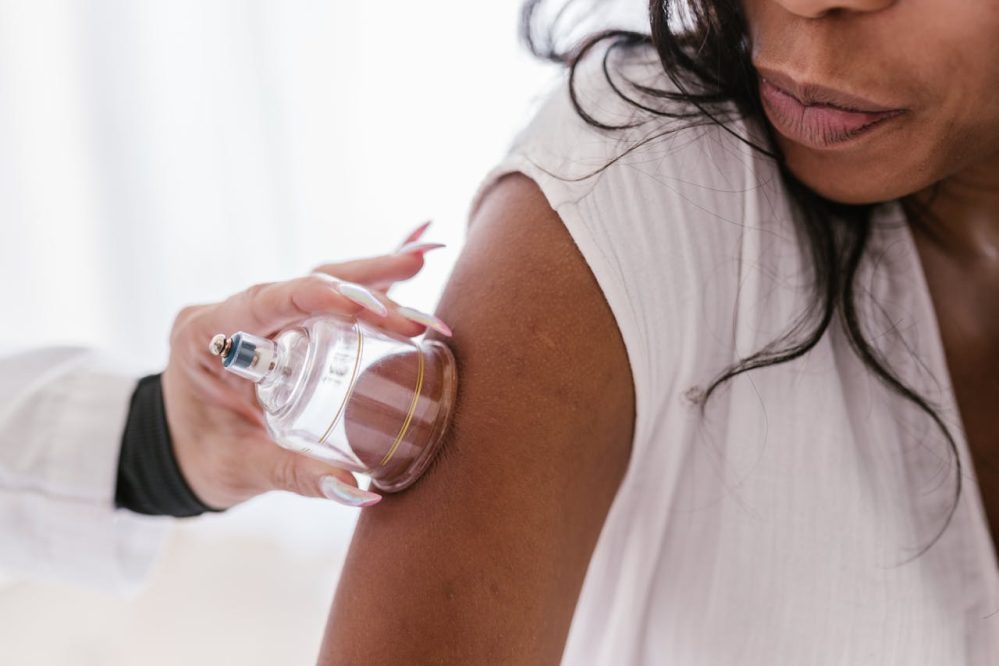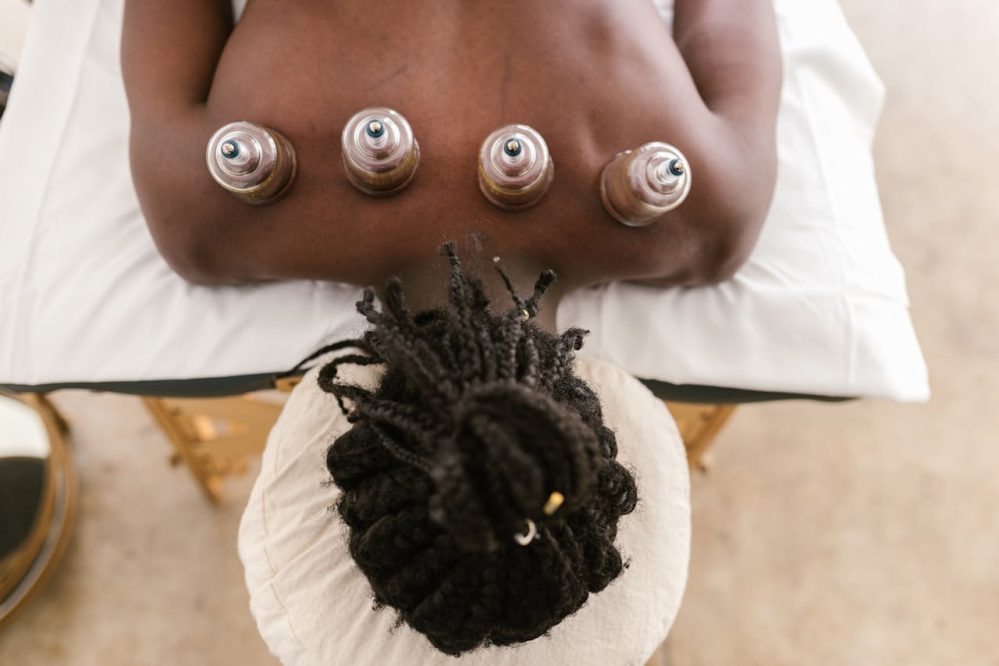Key Takeaways
— Cupping marks show up because the suction draws blood to the surface of the skin, which means your circulation is getting a boost and toxins are being released.
— Darker marks usually point to deeper blockages or toxins that need attention, while lighter marks are a sign that blood flow is pretty good and there’s less congestion.
— Typically, cupping marks will fade in anywhere from a few days to up to two weeks, depending on how intense they are and where they’re located.
Many people seek out massage therapy and alternative medicine as a natural, non-invasive way to feel better. The benefits of cupping, in particular, have earned it a place in many wellness routines. But let’s be honest: one of the things that often makes people hesitate is the sight of those circular marks that appear on the skin afterward.
If you’ve looked it up online, you’ve probably seen images of those reddish or purple cupping circles, and at first glance, they might seem a bit alarming. It may even seem like they’re painful, which raises questions like, “Is cupping really worth trying if it leaves these marks?”
The truth is, those marks are completely normal, and, in fact, they’re a sign that the cupping therapy is doing its job. Rather than indicating pain or harm, those marks show how your body is responding—releasing toxins, improving circulation, and starting the healing process.
What Causes Cupping Marks?
Cupping creates suction on the skin through the use of specialized cups, which can be made from materials like glass, bamboo, or silicone. When the air is heated or removed from the cups, it creates a vacuum that pulls the skin and underlying tissues upward. This suction stimulates blood flow, and according to traditional Chinese medicine, it helps those experiencing qi stagnation by improving its flow throughout your body.
As the skin is pulled into the cup, blood vessels underneath expand, causing blood to pool in the area. If there’s blockage—often due to muscle tension, injury, or poor circulation—cupping helps release it and improve the overall blood flow.
The marks you see afterward are simply the result of this suction process and can show you where blood flow was restricted. As circulation improves, the marks will eventually fade, indicating that the body is healing and detoxifying.
Cupping Marks and Their Meanings

Often mistaken for bruises, cupping marks are nothing like the kind of injury you might get from bumping into something. Instead, they’re part of the healing process, and each color they take on can reveal something about how your body is responding to the therapy.
Light pink or no marks
If you see light pink marks or—sometimes—no marks at all, that’s actually a great sign. It means that the blood flow in the area is in good shape, and there’s no significant stagnation or blockages to address. These marks, or lack thereof, indicate that your body is well-balanced, with no noticeable tension or toxins to work through.
Red marks
Bright red marks typically appear when there’s an acute issue like muscle tension, inflammation, or a recent injury. These marks indicate that the therapy is actively helping restore circulation in the area.
Red marks are often seen in areas that have been strained, such as tight muscles or joints. They’re an encouraging sign that the body is responding to the therapy.
Dark purple or black marks
If the marks are darker, like a deep purple or even black, they indicate chronic stagnation in the area. These darker marks occur when there’s a build-up of blood or toxins that have been trapped under the skin for a longer time.
Although they may look intense, they’re actually a good thing too—proof that cupping is helping to release deeper blockages and restore proper circulation.
Brown or yellowish marks
As the darker marks begin to fade, they often turn brown or yellowish. This color change means that the body is actively detoxifying, breaking down the toxins and waste products that were brought to the surface during the cupping session. It’s all part of the healing process.
Speckled or dotted marks
Speckled or dotted marks indicate concentrated areas of stagnation. These marks show up when suction pulls a high concentration of blood to a particular spot, creating a speckled or dotted appearance.
Such marks are a sign that cupping is targeting and working through specific areas of tension or blockage, which helps with circulation and the release of toxins in those regions.
How Long Do Cupping Marks Last?
The duration of cupping marks can vary quite a bit depending on a few factors. Generally, these marks last anywhere from a few days to about two weeks. Lighter marks tend to fade quicker, often within a couple of days, while darker marks may take longer, especially if they are a result of chronic issues.
A few factors can affect how long the marks last, such as the intensity of the marks themselves. Darker marks tend to stick around longer than lighter ones. Your skin type, too, can play a role; those with sensitive or fairer skin may experience longer-lasting marks.
The area of the body treated also matters—areas with more muscle tension, like the back, may have darker marks that take longer to heal. Of course, everyone’s body is different, so how well you take care of your marks and how well your body heals overall can influence the recovery time.
As the marks fade, there’s typically no pain associated with them, though you might feel some mild discomfort during the cupping session itself. Once the marks are formed, that sensation usually subsides, and there’s no lingering pain as the marks heal.
How to Reduce Cupping Marks Quickly

While cupping marks will fade on their own over time, some people may seek to speed up the process. Fortunately, there are a few simple things you can do to help reduce the appearance and duration of those marks.
Staying hydrated
As seems to be the answer to everything, drinking plenty of water helps fade these marks. Hydration after cupping can help flush toxins from your body, which supports circulation and the natural detoxification process. The more hydrated you are, the quicker the marks may fade.
Gentle massages
Gently massaging the treated area can help break up any remaining stagnation and promote blood flow. Just be sure to go easy—too much pressure can irritate the skin, so a light touch is best for supporting the healing process.
Warm compresses
Applying a warm compress to the area can soothe the skin and encourage circulation. The warmth helps blood flow and can speed up the healing process, but remember, the compress should be warm—not hot—to avoid any skin irritation.
Eating anti-inflammatory foods
Eating foods that help reduce inflammation, like leafy greens, turmeric, ginger, and omega-3-rich fish, can also help your body recover more quickly. These foods can help reduce swelling and promote tissue repair, speeding up the healing of cupping marks.
How Often Should You Get Cupping Therapy?
The frequency of cupping therapy really depends on what you’re looking to achieve. If you’re simply looking to maintain your overall well-being, then cupping once a week or even every two weeks can be enough. This frequency helps keep circulation flowing, relieve muscle tension, and support relaxation.
However, if you’re treating something more specific, like chronic pain, inflammation, or tight muscles, you may need more frequent sessions—about once or twice a week—until you start to see improvement. After that, you can space out the sessions.
It’s important not to overdo it, though. Cupping therapy, when done too frequently, can sometimes lead to skin irritation or bruising, especially if the suction is too intense. The body needs time to recover between sessions, so it’s essential to respect the recommended frequency to get the most out of the therapy.
In a few cases, you should avoid cupping altogether. If you have skin infections, open wounds, or conditions that affect your blood clotting, cupping may not be suitable for you. Pregnant women, those with heart disease, or people with serious chronic health conditions should consult with their doctor before trying cupping therapy.
If done improperly or too frequently, cupping could cause more harm than good, leading to excessive irritation or circulatory issues. That’s why it’s important to find a skilled therapist and follow their guidance carefully.
Benefits of Cupping Therapy

The benefits of cupping therapy go far beyond just leaving behind marks. This ancient practice offers a range of physical and mental health benefits that make it an appealing option for many.
Some of the key benefits include:
— Improves blood circulation
— Relieves muscle tension and pain
— Promotes detoxification and lymphatic drainage
— Supports relaxation and stress relief
— Enhances skin health and appearance
— Boosts immune system function
— Aids in healing injuries
— Improves flexibility and mobility
— Supports digestive health
— Reduces inflammation and swelling
The Bottom Line
Alternative medicine practices offer remarkable benefits for those seeking natural ways to improve their well-being. Unfortunately, a lack of information can sometimes lead to fear or hesitation—whether it’s about the marks left by cupping therapy or the needles used in acupuncture.
However, it’s important to remember that these therapies are incredibly safe and effective when performed by trained professionals. They’ve been practiced for centuries, and they’re backed by a deep understanding of the body and its responses.
If you’re inspired by the idea of providing relief to others through practices like massage therapy or acupuncture, you can make it a reality. Our programs, such as the Medical Massage Therapy or the Acupuncture Master Degree Program, can equip you with the knowledge and skills needed for careers in alternative medicine.
Many things in life become far less intimidating once you have the right information. Pursuing education in this field is no exception. If you feel even a bit uncertain, take a moment to explore our programs, read through the admissions requirements, explore our financial aid options, and discover all the exciting possibilities that lie ahead. We’re here to help you transform your interest in healing into an actual career.
Frequently Asked Questions (FAQs)
What not to do after cupping?
After cupping, it’s best to avoid hot showers, strenuous exercise, or direct sun on the cupped areas right away to allow your body to recover properly.
What does it mean when cupping hurts?
A little discomfort is normal during cupping, but if it feels too painful, it could be a sign that the area has more tension or blockages than usual that need attention—or it might mean the practitioner isn’t applying the technique correctly, especially if the suction is too strong.
What does severe stagnation after cupping mean?
Severe stagnation means there might be deeper blockages or a build-up of toxins in that area, which could take some extra time to clear and may cause darker marks.